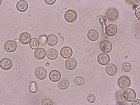Difference between revisions of "Eimeria spp."
Jump to navigation
Jump to search
| Line 6: | Line 6: | ||
Each sporulated oocyst has 4 sporocysts, each containing 2 sporozoites. The life cycles are direct, and transmission is via the faecal-oral route. | Each sporulated oocyst has 4 sporocysts, each containing 2 sporozoites. The life cycles are direct, and transmission is via the faecal-oral route. | ||
| + | |||
| + | {| cellpadding="10" cellspacing="0" border="1" | ||
| + | | Class | ||
| + | | Sporozoasida | ||
| + | |- | ||
| + | | Order | ||
| + | | Eucoccidiarida | ||
| + | |- | ||
| + | | Family | ||
| + | | Eimeriidae | ||
| + | |} | ||
| + | |||
| + | ''Eimeria praecox'' affects chcikens. The oocysts are colourless, and around 20μm in length. The endogenous stages occur in the villi. There are usually three stages of merogony, but there may be more. Then both sexual and asexual development occurs, and may be seen together. | ||
| + | |||
| + | The prepatent period is around 84 hours. | ||
[[Category:Coccidia]] | [[Category:Coccidia]] | ||
[[Category:To_Do_-_Max]] | [[Category:To_Do_-_Max]] | ||
Revision as of 10:51, 27 July 2010
| This article is still under construction. |
Eimeria spp. us the largest of the genus in the family Eimeriidae, and affects a large number of the domestic species found within the UK.
Each sporulated oocyst has 4 sporocysts, each containing 2 sporozoites. The life cycles are direct, and transmission is via the faecal-oral route.
| Class | Sporozoasida |
| Order | Eucoccidiarida |
| Family | Eimeriidae |
Eimeria praecox affects chcikens. The oocysts are colourless, and around 20μm in length. The endogenous stages occur in the villi. There are usually three stages of merogony, but there may be more. Then both sexual and asexual development occurs, and may be seen together.
The prepatent period is around 84 hours.
